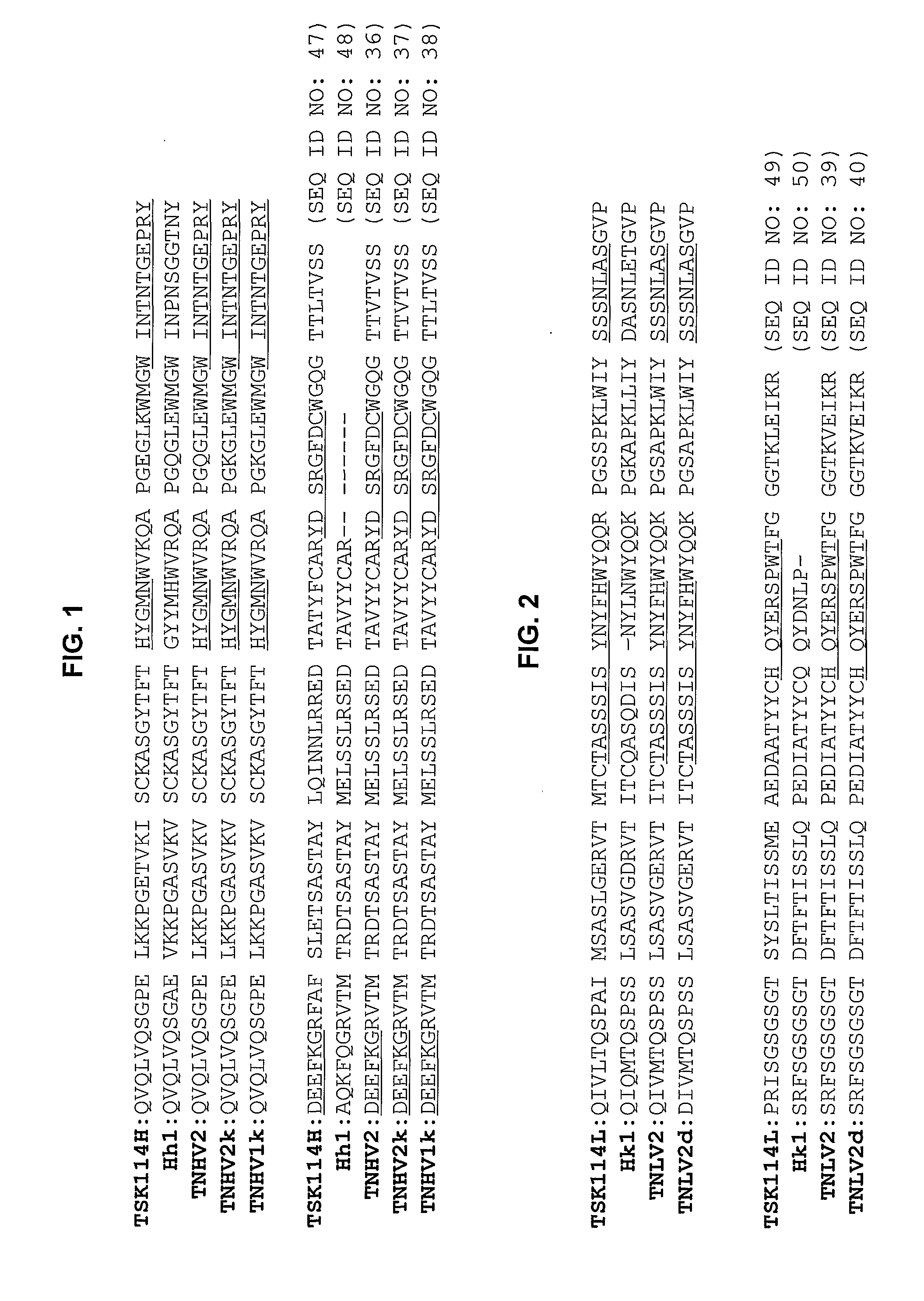Humanized Antibody Specific For Tumor Necrosis Factor-Alpha
a humanized antibody and tumor necrosis factor technology, applied in the field of humanized antibodies specific for human tumor necrosis factor, can solve the problem of human anti-mouse antibody formation
- Summary
- Abstract
- Description
- Claims
- Application Information
AI Technical Summary
Benefits of technology
Problems solved by technology
Method used
Image
Examples
example 1
Construction of a Gene Encoding a Heavy Chain Variable Region of a Humanized Antibody
[0051] PCR was conducted using a gene encoding the heavy chain variable region of the mouse monoclonal antibody TSK114 (Deposit Accession Nos: KCTC 10514BP and KCTC 10515BP) specific for TNF-α as a template and a primer pair of SEQ ID NOs: 1 and 14, to amplify gene A encoding the heavy chain variable region of the humanized antibody carrying a leader sequence. The amplified PCR product was electrophoresed on an agarose gel and recovered from the gel using QIAgel extraction kit (Qiagen, USA).
[0052] Gene A thus obtained was subjected to PCR with a primer pair of SEQ ID NOs: 1 and 7 or SEQ ID NOs: 6 and 14 to amplify DNA fragments, and overlapping PCR was performed using the resulting DNA fragments with a primer pair of SEQ ID NOs: 1 and 14. The amplified PCR product was incubated with TOPO vector (TOPO TA cloning kit, Invitrogen Inc., USA) at room temperature for 45 min to be cloned, and the cloned ...
example 2
Construction of a Full-Length Heavy Chain Gene of a Humanized Antibody and an Expression Vector Thereof
[0059] In order to construct the gene encoding the humanized full-length heavy chain using the gene encoding the heavy chain variable region inserted in pCR-TNHV2 Hv vector prepared in Example 1, pHAB-HC (KCTC 10229BP, Korean Patent Laid-open Publication No. 2004-12266) vector containing the gene encoding the heavy chain constant region of the human antibody was employed.
[0060] First, in order to insert gene TNHV2 encoding the heavy chain variable region of the humanized antibody into expression vector pHAB-HC, pCR-TNHV2 Hv was treated with HindIII / ApaI (BioLabs, Inc., USA) at 37° C. for 2 hrs, electrophoresed on a 1.5% agarose gel and stained with etidium bromide (EtBr), and an about 450 bp fragment of the gene was observed.
[0061] Also, pHAB-HC was treated with HindIII / ApaI, eletrophoresed and stained, and an about 6.5 kb fragment of the digested vector was observed. After then...
example 3
Construction of a Gene Encoding a Light Chain Variable Region of a Humanized Antibody
[0064] PCR was conducted using the gene encoding the light chain variable region of mouse monoclonal antibody TSK114 specifically recognizing TNF-α as a template and a primer pair of SEQ ID NOs: 16 and 30, to amplify gene A encoding the light chain variable region containing a leader sequence. Gene A was subjected to agarose gel electrophoresis and EtBr staining, and recovered from the gel using a QIAgel extraction kit.
[0065] Gene A thus purified was subjected to PCR with a primer pair of SEQ ID NOs: 16 and 25 or SEQ ID NOs: 24 and 30 to amplify DNA fragments, and overlapping PCR was performed using the resulting DNA fragments with a primer pair of SEQ ID NOs: 16 and 30. The amplified PCR product was incubated with TOPO vector (TOPO TA cloning kit, Invitrogen Inc., USA) at room temperature for 45 min, and the cloned vector was transformed into E. coli TOP10F′ to obtain a transformant. After incuba...
PUM
| Property | Measurement | Unit |
|---|---|---|
| dissociation constant | aaaaa | aaaaa |
| temperature | aaaaa | aaaaa |
| temperature | aaaaa | aaaaa |
Abstract
Description
Claims
Application Information
 Login to View More
Login to View More - R&D
- Intellectual Property
- Life Sciences
- Materials
- Tech Scout
- Unparalleled Data Quality
- Higher Quality Content
- 60% Fewer Hallucinations
Browse by: Latest US Patents, China's latest patents, Technical Efficacy Thesaurus, Application Domain, Technology Topic, Popular Technical Reports.
© 2025 PatSnap. All rights reserved.Legal|Privacy policy|Modern Slavery Act Transparency Statement|Sitemap|About US| Contact US: help@patsnap.com



